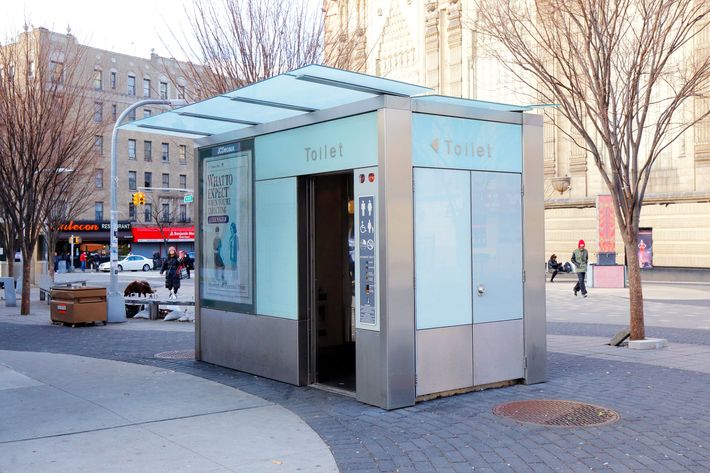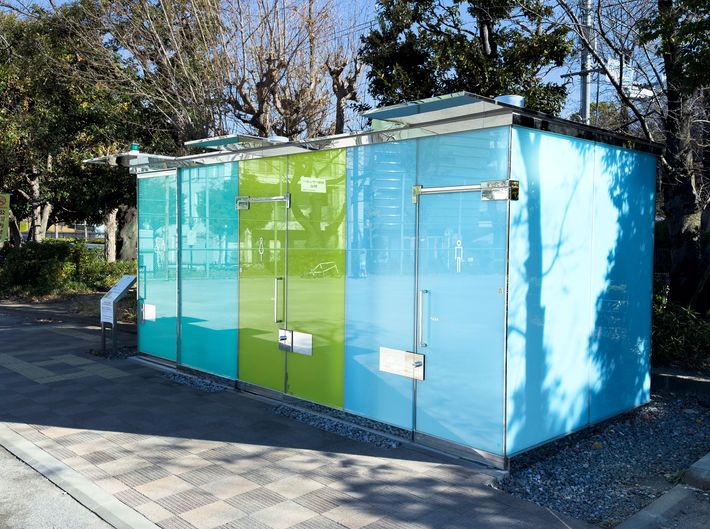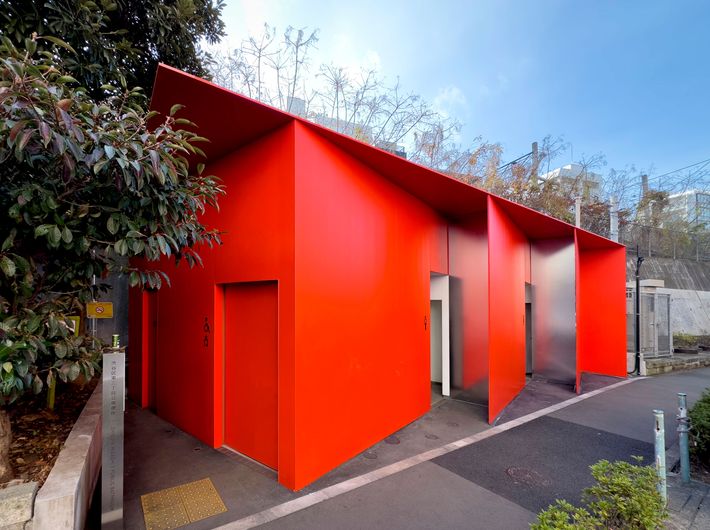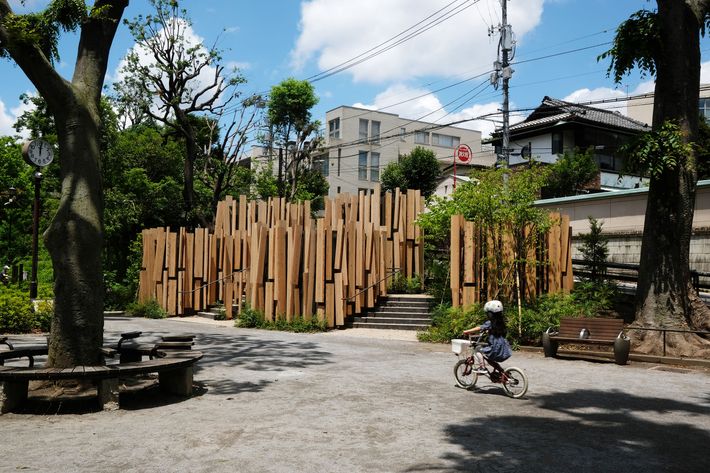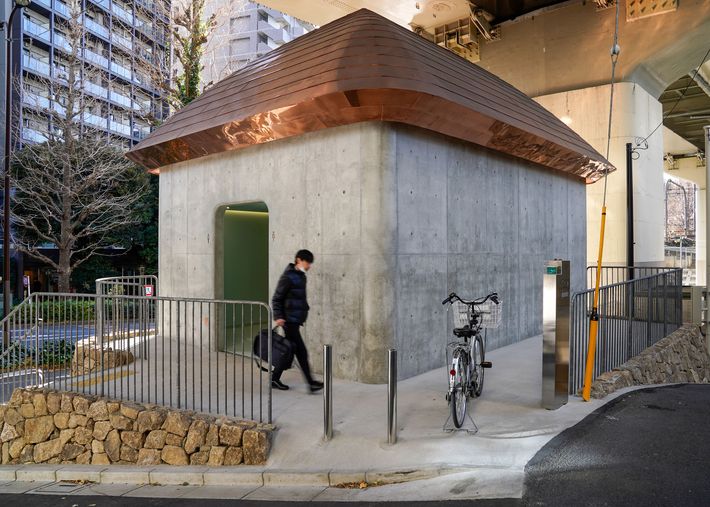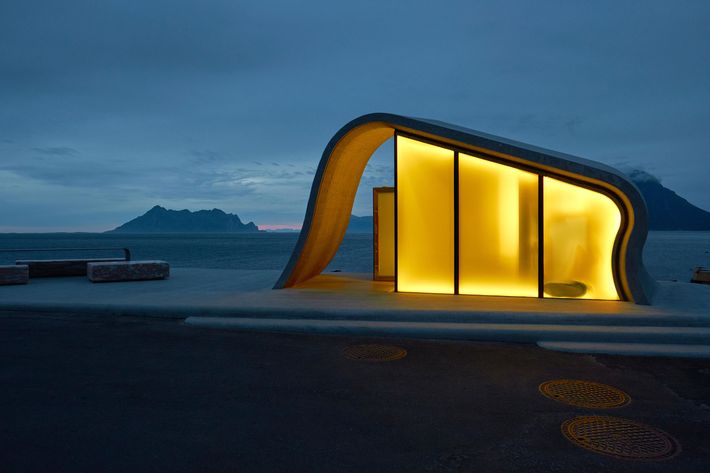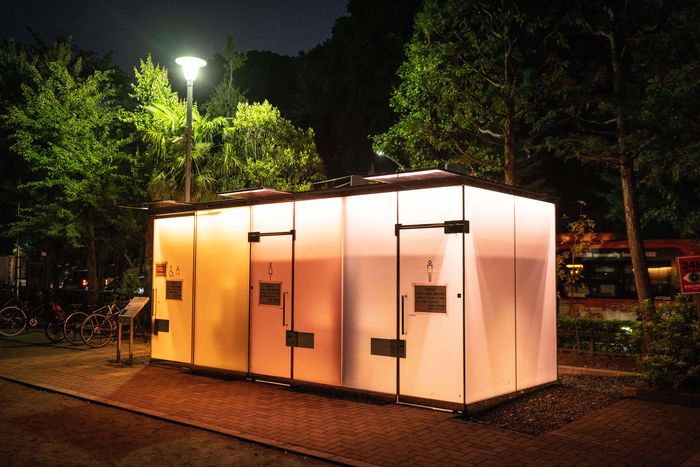
Movies are machines for generating envy, but you can keep your mauve sunsets and cinematic peaks, your luscious gowns and roast birds shellacked to implausible perfection. Wim Wenders’s tender and lovely film Perfect Days has fired me up with a new object of desire: public bathrooms as clean and beautiful as those in the Shibuya neighborhood of Tokyo. In the film, Koji Yakusho plays Hirayama, a gently taciturn man who nourishes his craving for order and poise through his profession as a toilet cleaner. Equipped with an arsenal of specialized tools, he performs a daily ritual of precise movements to maintain the gleam of 17 branded Tokyo Toilets scattered around Shibuya. And they exist in real life! They are neighborhood beacons, functional sculptures, mini-resorts for five-minute vacations, and shots of urban color created by an august array of designers and architects (including two Pritzker Prize winners). To a New Yorker who sees these gemlike installations pop up onscreen, and watches them get polished to a mirrored gloss, they seem like science fiction.
Shigeru Ban adorned two small Tokyo parks with glass boxes tinted in citrus hues, which seem at first like a perverse art project: a see-through, candy-colored toilet that takes the word public a bit too literally. Lock the door, though, and the translucent glass instantly frosts over, replacing the safety of being able to see in with the security of not being seen. Those are the most overtly spectacular designs in the Shibuya catalog, but they’re not even the ones most sensitive to their users’ timely needs. Kengo Kuma clustered five freestanding chambers, including one designed specifically for children, into a village sided with cedar planks. Nao Tamura fashioned a wedge of fire-red steel plates to fit on a narrow triangular site and to mirror the user’s “sense of urgency.” Marc Newson tucked a graceful concrete temple with a copper roof beneath a highway overpass, perhaps to communicate that spiritual and bodily needs are intertwined and can assert themselves anywhere. The firm Wonderwall exploded the ancient earthen hut into a mazelike composition of slender partitions. Some of the designs are fanciful, but all begin with an approach to making everyone — old people, toddlers, wheelchair users, tourists, habitués — feel comfortable and relaxed, maybe even a little exhilarated. That’s the point of architecture: to elevate ordinary human activities (and what is more ordinary than a bathroom break?) into experiences full of meaning and satisfaction. Sleeping, eating, staring at a computer screen, commuting, praying, reading — these procedures can, and mostly do, take place in the most basic enclosures. No good architecture is strictly utilitarian; it’s always an optional upgrade.


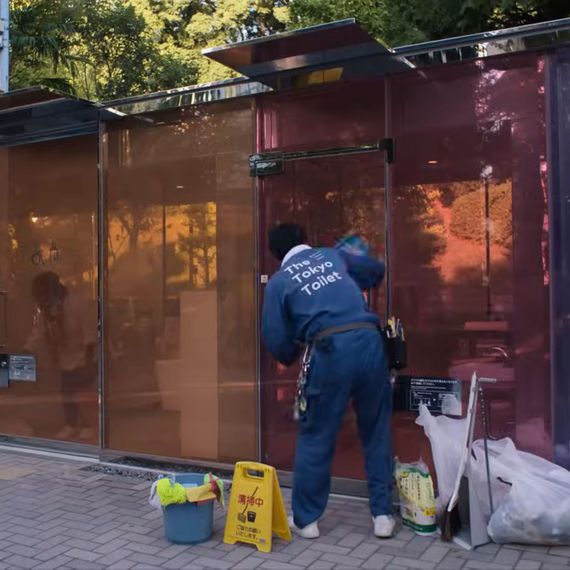
Tokyo’s example should make New Yorkers scream in frustration. Finding a public bathroom here is almost always a dispiriting challenge; using one can be worse. We have gotten used to cadging door codes from cashiers, striding into hotel lobbies as if we belong, jiggling the locked metal doors of playground restrooms, or getting inside to find pitted sinks and mysterious sedimentary deposits. (There are books and an excellent Instagram feed devoted to this stressful hunt.) In 2019, the comptroller’s staff heroically inspected every park bathroom in the city and found that many were damaged, dangerous, inaccessible, or unusable. The city has periodically tried to alleviate this desperation, but not so as you’d notice. A hopeful breeze wafted through Manhattan in the early 1990s, when, after years of political bickering, six self-cleaning pay toilets miraculously found their way to the sidewalks of Manhattan, purveyed by the French company JCDecaux. They worked, looked okay, brought relief, and didn’t turn into crack shacks. Four months later, they were gone. The pilot program “worked so well that the city [said it] would move ahead with plans to install more than 100 on busy sidewalks in all five boroughs,” the Times reassured readers in 1992. “If all goes according to plan, the officials said, the toilets would be ready by, say, the spring of 1994.” They were not ready then, or ever. In 2006, the Bloomberg administration made another deal — with Cemusa, later acquired by JCDecaux — to install 20 prefabricated toilets. Most of them have spent the last 18 years sitting in a warehouse in Queens.
When New York does erect a bespoke new facility in a park, it can take a dozen years and as much as $6 million, The City reported in 2019. (By contrast, the construction cost of each Tokyo Toilet, fitted out with the latest sensors, heaters, lights, and warm air blowers, comes out to roughly $800,000.) Our City Council recently passed a couple of pro-bathroom laws, including one requiring the Adams administration to come up with a list of potential locations for new ones by December 31, 2023. No word yet on that report — or on a bill compelling the city to actually build anything.
That sanitary paucity embodies the worst of New York’s approach to modernizing the physical city: preposterous costs, litigiousness, indolence, negativity, and a kind of reverse exceptionalism: Just because it works fine in other cities doesn’t mean it will work here. It also reflects the sense that using a bathroom is the definition of a private act, not a pressing public issue. Apartment owners who spend fortunes to remodel their own retreats aren’t necessarily interested in pitching in for a humble sidewalk outhouse. Consequently, the city doesn’t take this business seriously. Instead, it spends years, even decades, weighing objections to good ideas, checking proposals against onerous requirements, and shelving the whole project when it gets too complicated. Developers do only slightly better. The new privately owned public space at 550 Madison Avenue is one of just 13 (out of nearly 600) that have public bathrooms. It’s a nice one, by Snøhetta, though no auteur would make a film about it. Only Bryant Park has managed to earn a spot on the toilet hall of fame, by renovating a 1911 structure and tending it to five-star-hotel standards.
Tokyo got its showcase toilets thanks to a rich man with an idiosyncratic idea of public-spiritedness: Koji Yanai, the son of Uniqlo founder Tadashi Yanai and a senior executive at its parent company, Fast Retailing. The way Yanai tells it, he saw, and was stirred by, a promotional video for the 2016 Paralympics in Rio, with its montage of athletes and musicians overcoming disabilities with astonishing resourcefulness. For the 2020 Paralympic Games in Tokyo, he wanted to find a lasting way to express the Japanese concept of omotenashi, an extreme form of hospitality embodied in the tea ceremony. After a series of false starts, he came up with the idea of using design to ennoble the earthiest of human functions and serve everyone regardless of age, disability, or any other distinction. He didn’t make the Games, but he did use them to prod the city into a lasting civic improvement.
Tokyo already had an abundance of public bathrooms, but they tended to be as off-putting as ours. Yanai saw that the system worked poorly because it depended on selling sponsorships that few companies were interested in. A dingy bathroom doesn’t make a great advertising opportunity. So Yanai turned his fantasy into a personal mission. He hired the designers, recruited the Nippon Foundation to supervise construction, and sweet-talked the Shibuya ward into accepting the gift. Demonstrating the talent for marketing that has helped make Uniqlo ubiquitous in closets around the world, he also recruited Wenders to make what must be the most sublime promotional film in the history of wastewater plumbing.
Crucially, Yanai budgeted for the obsessional level of maintenance embodied by the fictional Hirayama. He also insisted that the private company Tokyo Toilets, not a public bureaucracy, be responsible for keeping up standards. Wenders’s movie is really about caring, not design. Hirayama tends to his tiny corner of the world — his body, his snapshots of trees, his Kinks and Lou Reed cassettes, and, of course, his toilets — with a reverence that borders on the religious. That version of omotenashi doesn’t translate well here. The challenge of maintenance keeps coming up in fatalistic explanations for why such a basic public amenity seems out of reach in New York. In our fallen state, finely crafted bathrooms would soon be filthy, covered in graffiti, vandalized, commandeered by junkies, and quickly put out of service. The prevailing philosophy about public facilities of all kinds is that they must be indestructible and require minimal upkeep, since that is what they will get. Fighting the forces of disintegration is too costly and requires too much vigilance. These are the arguments of a society driven by self-disgust. And the result of all these objections, delays, denials, and neglect is indeed disgusting: a city where the best option for some people is the gap between parked cars. This may be the capital of the world, but, let’s face it, it reeks of urine.
A program of free, high-tech, designer toilets for all is the appurtenance of an affluent society. (And not just Japan’s: I once spent an enjoyable week touring some of Norway’s magnificently scenic and dramatically designed rest stops; the world’s most exhilarating public-bathroom experience may be at Ureddplassen, where you can pee with a view of an icy seascape and sharp-pointed peaks.) When Yanai delivered a lecture at Harvard’s Graduate School of Design, the Indian architect Rahul Mehrotra pointed out that his country had one toilet seat (public or private) for every 1,400 rear ends. If the government of India could supply millions of its people with an alternative to an open ditch, that alone would be a miraculous achievement. The scale of that inequity should make us appreciate how relatively trivial our challenges in public sanitation are — and how easy and rewarding it would be to overcome them. Surely the metropolis that calls to the world with its ever-expanding museums, multiplying concert halls, thin-air observation decks, and destination parks can manage somewhere decent to pee? The only penury we can legitimately plead is poverty of imagination.



